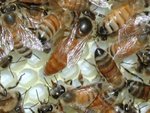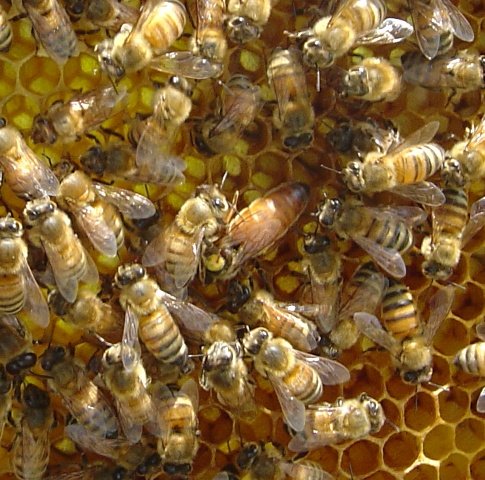Right: Emerged queen cell. A new queen has emerged from this cell within the past week. Worker bees are in the process of demolishing the cell. A new queen cell can be seen to the left of the emerged cell. A worker in inside the cell tending to the queen larva.
Last week I found that the bees had built more queen cells and I decided to let them replace the old queen.
I have been concerned that it is too early in the spring for mature drones to be available for mating.
Left: The new queen. Can you find her? I expected to find a virgin queen since it usually takes two weeks for a queen to mate and start to lay eggs. I found new eggs everywhere in the hive. I beleive she is laying
Sure enough, upon inspection, I found that one of the queen cells had emerged. The empty cell was in the process of being destroyed by the workers. I estimate that the new queen emerged a few days earlier.
I searched to find the virgin queen. Sure enough I found her, but I also found eggs…. Lots and lots of eggs. I guess she is not a virgin any more.
Right: Enlarged area of photo above showing closeup of the new queen. I am concerned that she is small. Queen ususally enlongate after mating. I will check her in a week to see how she is doing.
Could this queen have mated and started laying in less than a week? My experience has been that a queen will take up to two weeks after emergence to mate and start to lay. This queen seems to have done it in less than a week.
I am concerned that she seems a little on the small side. If the bees are happy with her I will let her stay until a better queen is available later this spring.
I am now kicking myself for destroying the beautiful large queen cell that was built at the beginning of the month. Sometimes I need to just let the bees be bees. They know their business better than I do.
Left: A worker bee bringing pollen into the hive with the new queen. With new eggs there will be young larva to feed in a few days.
On the other hand however, I have been watching one of my hives dwindle down in size. There is no sign of disease. The queen was very successful last season and the hive was strong all winter. Now they will not survive another week. Why… I don’t know.
The question for a beekeeper always is, When to I let nature take its course, and when do I intervene.




















